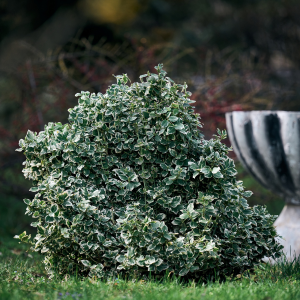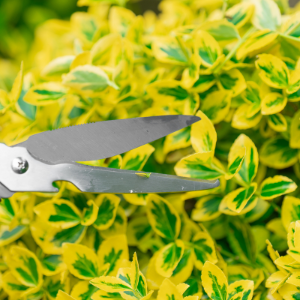The Ultimate Guide to Euonymus Hedge Plants
Euonymus are simply brilliant, ornamental shrubs. You might know them better by their common name, spindle, and their great attraction lies in their sheer versatility. They can be grown for a formal, structured look in garden borders, the evergreen varieties make unbeatable hedging and they always look classy showcasing pathways or low borders in kitchen gardens. When left to grow naturally, they have a bushy habit that creates an informal look which is great for cottage, seaside or gravel gardens. If you want to create a more formal garden style, why not try topiarising or growing them against a sunny wall?
Euonymus is a family of over 130 flowering species including the ever-popular deciduous and evergreen shrubs. However there are some small trees too, so it’s no surprise that here at Hedges Direct we have a fantastic selection of the best Euonymus plants Euonymus plants for your garden. For those looking for instant evergreen hedging or attractive garden divisions, we also offer mature instant hedging.
Our most popular varieties of Euonymus hedging plants
We have a fabulous selection of the best Euonymus hedging plants whatever your garden size. By choosing one of our tempting varieties you’ll be adding a low-maintenance, attractive shrub that adds gorgeous texture and colour to your garden throughout the year. If your garden has suffered from Box Blight, some Euonymus combine all the appeal and practicality of box plants without the stress, so you might consider replacing damaged box hedging with this robust alternative.
- Euonymus japonicus ‘Jean Hugues’ displays lush, dark green, glossy compact foliage and makes a popular alternative to Box (Buxus sempervirens) without suffering from any of the problems of Box blight. Discover more options in our Box alternatives guide.
- Euonymus fortunei Emerald ‘n’ Gold is every bit as regal as its name suggests with marbled green leaves edged in rich gold. Its colourful interest doesn’t stop there, since its autumn foliage fades to attractive soft shades of pink and red.
- Euonymus fortunei ‘Emerald Gaiety' has elegant semi-evergreen silver-edged foliage, or you might enjoy the bushy Euonymus japonicus ‘Kathy,’ with its elegant polished, fresh mid-green leaves and appealing creamy edging.
- Euonymus japonicus ‘Ovatus Aureus’, offers variegated dark green leaves with rich yellow margins. In addition to its delightful foliage, pale green flowers appear in spring, occasionally followed by pink fruits.
- Euonymus japonicus 'Kathy' is similar to 'Ovatus Aureus' but features attractive variegated green and cream leaves. The foliage has a darker centre graduating paler towards the edges with their creamy-white margin and white leaf tips.
Planting Euonymus


Why Plant Euonymus?
Euonymus is universally loved for its outstanding leaf colour ranging from plummy purples to vibrant greens that can be gold or silver-edged. Whilst they are loved for their appealing foliage, they have foaming sprays of pretty pink or creamy flowers in spring often followed by attractive pink, and white berries so they earn their stripes in offering colour and interest throughout the year.
As many of our Euonymus plants are evergreen, their fantastic foliage provides long-lasting shape and colour giving enticing year-round interest.
No matter what size your garden is, you’ll find a stylish Euonymus to suit every outdoor space and many compact varieties can be grown in pots on a sunny or lightly shaded patio.
As many of our Euonymus plants are evergreen, their fantastic foliage provides long-lasting shape and colour giving enticing year-round interest. No matter what size your garden is, you’ll find a stylish Euonymus to suit every outdoor space and many compact varieties can be grown in pots on a sunny or lightly shaded patio.
When to plant Euonymus
Spring and autumn are the ideal time to plant Euonymus when the soil is warm because this gives the plant’s roots time to settle down. Naturally, if you are planting a pot-bought plant, you can plant them at any time of the year but avoid planting in frozen or waterlogged soil.
Where to plant Euonymus
The wonderful thing about Euonymus is they are pretty unfussy and can cope with any reasonable, well-drained garden soil in sun or light shade although many of the evergreen varieties fare better in full sun as it retains the colour of their contrasting foliage. You’ll be delighted to learn that some varieties can cope with shady areas as well as windy or coastal conditions, so there’s a plant for every location.
How to plant Euonymus
There are a few useful tips to consider when planting Euonymus to ensure they get a good start and keep them looking their best.
- Always water the potted plant before planting.
- For the best flower displays, choose a sunny spot if you want an abundance of blooms. If you are planting one of the variegated types, they like a sunny spot to retain their vibrant leaf colour.
- Dig a hole about twice as wide and deep as the pot the plant is currently in.
- Add a handful of well-rotted organic matter to the bottom of the hole, and be sure to remove any surrounding weeds as well as rocks and debris from the hole before planting.
- Place the Euonymus plant in the hole and backfill it with soil, making sure to firm it down well before watering the plant again.
Euonymus Pruning and Aftercare
When to prune Euonymus
Most Euonymus require nothing more than a light trim and tidy-up. Euonymus are usually trimmed back to retain their size and shape after flowering, however, it’s always a good idea to remove any dead, broken or diseased branches in spring to keep the plant healthy and looking its best. As a general rule of thumb, trim shrubs lightly to encourage light growth and prune harder to generate stronger growth. If you’ve inherited a large, unruly garden shrub that has outgrown its space or is crowding other plants, you can prune the evergreen types such as Euonymus japonica much harder and reduce the overall growth by about 30-50%. It might look unsightly for a bit but the following season it will be restored to its former beauty.


How tall does Euonymus grow?
Depending on the variety you’ve chosen to grow, Euonymus ranges widely in height from 60cm to 2.5m tall, so even if you have no garden at all, the smaller varieties will thrive very happily in pots or containers.
How fast does Euonymus grow?
Euonymus can put on between 10-20 cm of fresh growth each year so they are super -easy plants to maintain and you shouldn’t need to clip them more than once a year.
Add a Euonymus hedge plant to your garden with Hedges Direct Pruning, Planting and Aftercare.
If you’ve decided to grow Euonymus in your garden, you’ve wisely chosen a dependable ally since Spindles are incredibly reliable, pretty much trouble-free and low maintenance.
For seaside gardeners who are faced with extreme weather conditions where plant choices can be limited, don’t worry, you can achieve all of your gardening goals no matter what your location since Euonymus is a tough species with an impressive success rate in all kinds of exposed locations and coastal environments.
Get in touch with our Hedges Direct expert team today on 01257 263 873 or email us at [email protected] for more information on our Euonymus hedge plants.
Frequently Asked Questions
It's best to take Euonymus cuttings in late spring or early summer when the plant is actively growing. Look for healthy, non-flowering shoots and choose cuttings that are around 10-15 cm long. Carefully remove the lower leaves, dip the cut end in rooting hormone, and plant them in a well-draining rooting medium, like perlite, vermiculite, or peat moss. Place the cuttings in a warm and humid spot to keep them happy until roots develop. Once rooted, you can transfer them to individual pots or your desired garden location.
A few things could cause your Euonymus to struggle: improper watering, poor drainage, fungal diseases, insect pests, extreme temperatures, or not enough sunlight. Take a closer look at how you water the plant, check the soil's quality and drainage, and inspect for signs of pests or diseases.
Euonymus plants don't have very deep roots. Typically, their roots extend about 30-45 cm into the soil. Every Euonymus is different, though, so the exact depth and spread can vary depending on the species and growing conditions.
Euonymus hedges can face pests like aphids, scale insects, spider mites, and caterpillars. Diseases such as powdery mildew, leaf spot, and crown gall can also affect them. The best way to reduce the chances of pests and diseases infecting your Euonymus hedge is by regularly checking it for signs of damage, so you can catch it and take action early.
Prune any dead, dying, or diseased branches and safely dispose of the clippings to prevent reinfection and practise good gardening hygiene by disinfecting your tools after use.
Euonymus hedges prefer full sun to partial shade for their best growth. While they can tolerate some lack of natural light, deep or prolonged shade can affect their vigour and density. In sheltered areas, Euonymus hedges may become sparser, grow slower, and have less foliage. If you're planting in a spot without much sun, consider choosing shade-tolerant varieties like Euonymus fortunei 'Emerald 'n' Gold'.
 Hedges Direct
Hedges Direct 



